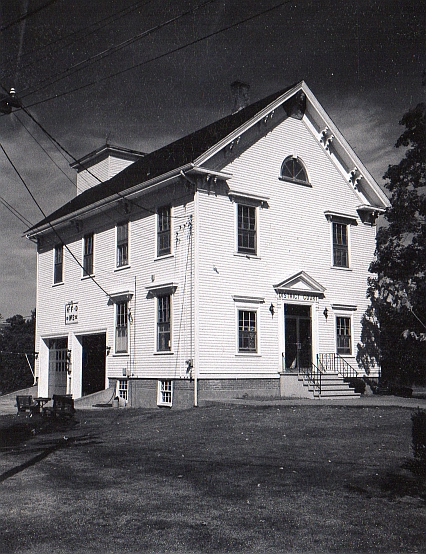By Liz Premo, Atlantic News Staff Writer
Atlantic News, Friday, November 11, 2005
[The following article is courtesy of Atlantic News]

HAMPTON -- Should it stay, or should it go?
Now that the decision has been made to relocate its internal operations to a temporary location in Seabrook, the future of the Hampton District Courthouse is certain to be at the forefront of many an upcoming discussion pertaining to the structure's historical significance.
The building — mold, asbestos and other nasties notwithstanding — still has rich tales to tell of Hampton's immediate and distant past, and of its function as (at various times) a meeting house, a grammar school, an American Legion hall, and a fire station.
In short, "It's an important building, and it's important to save it," says Elizabeth Aykroyd, a member of both the Hampton Historical Society and the Heritage Commission.
Aykroyd was understandably distressed to hear that the possible fiery destruction of the building by means of a "controlled burn" had been mentioned in passing at a recent meeting of the Hampton board of selectmen.
Though that course of action is probably some time away from either being shot down, agreed upon or even actually utilized, local history buffs may be relieved to hear that intent to preserve the building has been discussed "over a number of years," according to Aykroyd.
The timeliness of the topic led Aykroyd to add it to the agenda for this week's meeting of the town's Heritage Commission, of which she serves as chairman. The meeting was scheduled for Wednesday, November 9; an account of what transpired was not available as of press time.
Earlier this week, Aykroyd indicated that she felt this "preliminary discussion" would hopefully set an effort in motion to not only save the building from demolition, but to preserve and restore it for future use by the public as an historical structure worth saving.
Noting she felt the endeavor would be something her fellow board members would support, Aykroyd emphasized that such an effort would not be inexpensive. However, there may be at least one light at the end of the tunnel, in the form of a "Preserve America" grant.
According to its federal government Web site, the Preserve America matching-grant program "provides funding to support preservation efforts through heritage tourism, education and historic preservation planning." The site adds that grant applications are now available "to assist local economies in finding self-sustaining ways to promote their cultural resources through heritage tourism."
Aykroyd also indicated that she hopes a collaboration between the Heritage Commission and the Hampton Historical Society will provide the requirements needed to qualify for this type of grant.
In any event, Aykroyd says that the process will move along best if done slowly and by "taking baby steps."
So what is it that makes this 19th century building so important to Hampton history, besides its age?
According to information provided by the Lane Memorial Library's Hampton History Volunteer, John Holman, the two-story structure was built in 1873 for a total of $4,485. Measuring 47'x 32' with 11' ceilings, the building was originally known as the Hampton Grammar School and was located on Winnacunnet Road, on the current site of Centre School.
When Centre's familiar brick building was constructed in 1921-22, its smaller white, wood frame counterpart was moved to the corner of Winnacunnet Road and Academy Avenue. There, notes Holman, it served as "Hampton's first public Kindergarten, American Legion Post #35 hall, Fire Station #2 from 1932 (until the new station was built), and more recently the Hampton District Court House until November 7, 2005."
(Note: Effective November 14, 2005, the Hampton District Court will be moving temporarily to 130 Ledge Road in Seabrook, until a permanent facility is built.)
When the building was used as a fire station, the town's fire engines were parked fully inside the lower level, its double-doored entrance leading to Academy Avenue. A sign posted on the side of the building reads, "HFD, No. 2, 1932" and has been touched up with a fresh coat of paint in recent years.
As a meeting place of the past, says Aykroyd, the facility was used by civic groups of spotless reputation (the Boy Scouts, the American Legion, the Girl Scouts) and those of somewhat dubious distinction (the Ku Klux Klan). Even the Red Cross used it during times of war as a place to roll bandages.
In its career as a court house, the facility has seen countless legal proceedings within its echo-prone chambers. Some infamous, and perhaps not-so-famous criminals have passed through its portals: Pamela Smart and her accomplices, for example, or simply those who chose to party a little to hearty down at Hampton Beach on a summer's night.
Whatever its future, the structure that stands on the corner of Winnacunnet Road and Academy Avenue has a history that would resonate richly throughout every room, if walls could talk. And if efforts to save it can begin and progress with success, another significant piece of Hampton history will be preserved for generations to come.
